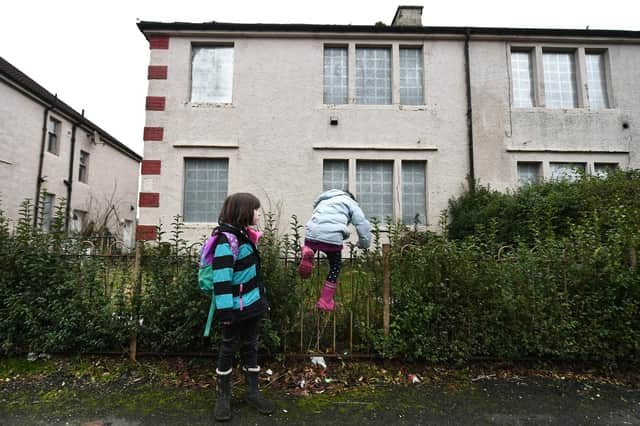Dani Garavelli: A safe home should not be a luxury


The links practitioner was helping him to apply to various housing associations, but the waiting lists were long and her expectations were low. The man was hoping to be prioritised on the grounds of his son’s neurodivergence, but GPs do not generally write supporting letters to housing providers, and, while the links worker could have written herself, her letter was less likely to carry weight.
Recognising the pressure the family was under, she tried to point him in the direction of autism support groups, but he was too consumed by his immediate crisis to take in what she was saying, and too scared to accept his landlord couldn’t evict him without going through the proper legal processes. If the landlord wouldn’t act, the links practitioner told me, he might end up in temporary homeless accommodation. His family was facing so many challenges: poverty, language barriers, racism. “Just layer upon layer of exclusion,” she said.
Advertisement
Hide AdAdvertisement
Hide AdI thought of this man last week when I heard about two-year-old Awaab Ishak who died as a direct result of untreated mould in his Rochdale home. That their flat belonged not to a unscrupulous private landlord but to Rochdale Boroughwide Housing Association (RBH) only makes the dereliction of duty more pronounced.
Awaab’s father, who came to the UK in 2015 from Sudan, had been complaining to RBH since before his son was born. But, instead of acting, RBH engaged in a toxic, yet widespread, blend of victim-blaming and racism, claiming – without evidence – that the problem was being fuelled by “ritual bathing”. This, plus bureaucratic crossed wires plus a medical miscommunication, led to an avoidable tragedy. It is an indictment of individuals, systems and a policy of housing deregulation which has left families vulnerable to cost-cutting and slum conditions.
Knocking on doors around the Freehold estate, where many asylum seekers are housed, Manchester Evening News reporters encountered a succession of residents engaged in similar battles. One couple with an asthmatic daughter spoke of being unable to shift the mould even in July with two dehumidifiers running and all the windows open.
Nor are these problems confined to Rochdale. In England, at least 120,000 households in social housing, and 176,000 in privately rented accommodation, are said to be affected by condensation and mould. In Scotland, a recent Edinburgh City Council report found 500 council house tenants had reported damp-related problems over a three-month period, while an investigation by the Press & Journal revealed North-east councils consistently failed to fix mould in social housing.
This could be exacerbated in future. Guidance seen by the Observer, expected to come into effect by April 2023, suggests councils inspecting rented properties will be formally instructed to examine residents’ behaviour – such as whether they are taking enough steps to ensure their property is heated and ventilated – when deciding whether to take action against landlords over dangerous conditions.
Back at Govanhill, damp is exacerbated by overcrowding, with extended families crammed into tiny flats. Such families – often Roma – are stigmatised and subjected to individual and institutional racism. It is not unknown for professionals to imply Roma families deliberately overcrowd properties when they have homes in eastern Europe they could return to. It is also worth noting that, unlike England, were a child to die in similar circumstances to Awaab here, there would be no automatic Fatal Accident Inquiry, and therefore, potentially, less clamour for change.
It was the damning comments made by Joanne Kearsley, the coroner at Awaab’s inquest, that exposed the scandal and sparked public outrage. Kearsley said the toddler’s death ought to be “a defining moment” for the housing sector. But if the Grenfell Tower fire wasn’t a defining moment – if cost-cutting and racism continue to blight the lives of vulnerable families now – how can we be confident this tragedy will be a catalyst for change?
Nor has the response of RBH provided reassurance. The housing provider admitted it should have carried out repairs. It also seemed to accept the kind of lifestyle factors it once blamed for mould - – such as cooking, showering and breathing – were things rich people do too, only in properties that are properly ventilated and maintained. Yet, because the concept of accountability perished the day Boris Johnson became prime minister, its CEO Gareth Swarbrick clung on to his £185,000-a-year job until yesterday, when he was finally fired. “The board has taken the decision to remove Gareth Swarbrick from his post as chief executive of RBH with immediate effect,” the landlord said in a statement.
Advertisement
Hide AdAdvertisement
Hide AdSince Grenfell, new laws have been drawn up. The Housing (Amendment) (Scotland) Act 2018 gave the Scottish Housing Regulator more control over registered social landlords (RSLs). South of the Border, it has taken five years for the Social Housing (Regulation) Bill to stutter its way to Westminster. If approved, it will allow the housing regulator to proactively inspect properties, take action even where tenants are not deemed to be at risk of “serious detriment” and impose higher fines.
Shelter says it’s a step in the right direction, but wants tougher action still. Last week, thousands signed a petition calling for “Awaab’s Law”, which would require landlords to investigate the causes of damp and mould within 14 days of complaints being made, and provide tenants with a report on the findings. Where a medical professional believed there was a risk to a tenant's health, social landlords would have just seven days to begin repairs.
Such measures cannot come quickly enough. With winter approaching and the cost of living crisis deepening, more and more people will be forced to cut back on heating, leading to an increase in condensation and mould. As Awaab’s death proves, the consequences may well be fatal.
Comments
Want to join the conversation? Please or to comment on this article.